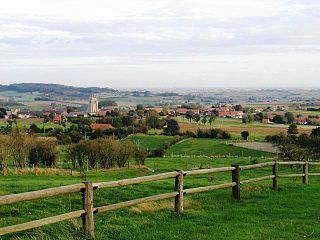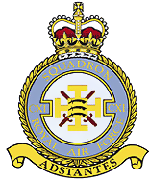Related Research Articles

Heuvelland is a municipality located in the Belgian province of West Flanders. The municipality comprises the villages of Dranouter, Kemmel, De Klijte, Loker, Nieuwkerke, Westouter, Wijtschate and Wulvergem. Heuvelland is a thinly populated rural municipality, located between the small urban centres of Ypres and Poperinge and the metropolitan area of Kortrijk-Lille along the E17. On 1 January 2006 Heuvelland had a total population of 8,217. The total area is 94.24 km2 which gives a population density of 87 inhabitants per km2. The name heuvelland is Dutch meaning "hill country", as the municipality is characterized by the different hills on its territory.

Number 17 Squadron, currently No. 17 Test and Evaluation Squadron (TES), is a squadron of the Royal Air Force. It was reformed on 12 April 2013 at Edwards Air Force Base, California, as the Operational Evaluation Unit (OEU) for the Lockheed Martin F-35B Lightning.

Number 216 Squadron is a squadron of the Royal Air Force based at RAF Waddington, Lincolnshire, since reforming on 1 April 2020 and is tasked with testing future drone swarm technology. It had previously operated Lockheed TriStar K1, KC1 and C2s from RAF Brize Norton, Oxfordshire, between November 1984 and March 2014.

Number 111 (Fighter) Squadron, also known as No. CXI (F) Squadron and nicknamed Treble One, was a squadron of the Royal Air Force. It was formed in 1917 in the Middle East as No. 111 Squadron of the Royal Flying Corps during the reorganisation of the Egyptian Expeditionary Force after General Edmund Allenby took command during the Sinai and Palestine Campaign. The squadron remained in the Middle East after the end of the First World War until 1920 when it was renumbered as No. 14 Squadron.

The Battle of the Lys, also known as the Fourth Battle of Ypres, was fought from 7 to 29 April 1918 and was part of the German spring offensive in Flanders during the First World War. It was originally planned by General Erich Ludendorff as Operation George but was reduced to Operation Georgette, with the objective of capturing Ypres, forcing the British forces back to the Channel ports and out of the war. In planning, execution and effects, Georgette was similar to Operation Michael, earlier in the Spring Offensive.

Gent–Wevelgem, officially Gent–Wevelgem – In Flanders Fields, is a road cycling race in Belgium, held annually since 1934. It is one of the classic races part of the Flemish Cycling Week, run in late March on the last Sunday before the Tour of Flanders.

Number 56 Squadron, nicknamed the Firebirds for their ability to always reappear intact regardless of the odds, is one of the oldest and most successful squadrons of the Royal Air Force, with battle honours from many of the significant air campaigns of both the First and Second World Wars.

Number 92 Squadron, also known as No. 92 Squadron and currently as No. 92 Tactics and Training Squadron, of the Royal Air Force is a test and evaluation squadron based at RAF Waddington, Lincolnshire. It was formed as part of the Royal Flying Corps at London Colney as a fighter squadron on 1 September 1917. It deployed to France in July 1918 and saw action for just four months, until the end of the war. During the conflict it flew both air superiority and direct ground support missions. It was disbanded at Eil on 7 August 1919. Reformed on 10 October 1939,at Tangmere Airfield, the unit was supposed to be equipped with medium bombers but in the spring of 1940 it became one of the first RAF units to receive the Supermarine Spitfire, going on to fight in the Battle of Britain.

X Corps was a corps of the British Army that served in the First World War on the Western Front before being disbanded in 1919. The corps was re-formed in 1942 during the Second World War and saw service in the North African Campaign and the Italian Campaign where it came under command of the US Fifth Army and the British Eighth Army.

Friedrich Bertram Sixt von Armin was a German general who participated in the Franco-Prussian War and the First World War. In the latter he participated in many battles on the Western Front, including the Battles of Passchendaele and the Lys.

13th Corps was a corps-sized formation of the British Army that fought on the Western Front during the First World War and was reformed for service during the Second World War, serving in the Mediterranean and Middle East throughout its service.

Franz, Prince of Bavaria was a member of the Bavarian Royal House of Wittelsbach and a Major General in the Bavarian Army.

The 7th (Southland) Mounted Rifles was raised on 17 March 1911. During World War I they formed part of the Otago Mounted Rifles Regiment and served in the Battle of Gallipoli and was then withdrawn to Egypt. They would later serve in France, with the New Zealand Division.

The Otago Mounted Rifle Regiment was a New Zealand Mounted Regiment formed for service during World War I. It was formed from units of the Territorial Force consisting of the 5th Mounted Rifles, the 7th (Southland) Mounted Rifles and the 12th (Otago) Mounted Rifles. They saw service during the Battle of Gallipoli, with the New Zealand Mounted Rifles Brigade and was later withdrawn to Egypt. They later left the brigade and served in France with the New Zealand Division becoming the only New Zealand Mounted troops to serve in France.

Karl Höfer also Hoefer; was a German general. During World War I he became known as the Held vom Kemmelberge (hero of Kemmel hill) after his division had captured the Kemmelberg during the Fourth Battle of Flanders.

Kemmelberg is a hill formation in Flanders, Belgium. It is located less than a kilometer from the village of Kemmel, part of the municipality of Heuvelland in West Flanders.
Gaza was a battle honour awarded to units of the British and Imperial Armies that took part in one or more of the following engagements in the Great War:
The 2016 Gent–Wevelgem, was a one-day cycling classic that took place on 27 March 2016. It was the 78th edition of the Gent–Wevelgem race and the seventh event of the 2016 UCI World Tour. The race followed a 243-kilometre (151 mi) course that started in Deinze and ended in Wevelgem in Belgium, with a portion of the race spent in northern France. The race included ten climbs, several of them cobbled, which provided the principal difficulty in the race. The last and most difficult climb was the Kemmelberg. The favourites for the race included Alexander Kristoff, Fabian Cancellara (Trek–Segafredo), and Peter Sagan (Tinkoff).

The fifth edition of the Gent–Wevelgem women's race was held on 27 March 2016. It was a one-day road women's cycling race in Belgium. It was included in the inaugural Women's World Tour, coming as the fourth round of the competition. Dutch rider Chantal Blaak won the race after a solo attack.
The sixth edition of Gent–Wevelgem – In Flanders Fields was held on Sunday 26 March 2016. It was the women's event of Gent–Wevelgem cycling race, held in Belgium. It was the fourth race of the 2017 UCI Women's World Tour season.
References
- ↑ T.F. Mills France and Flanders (archive of Regiments.org page)